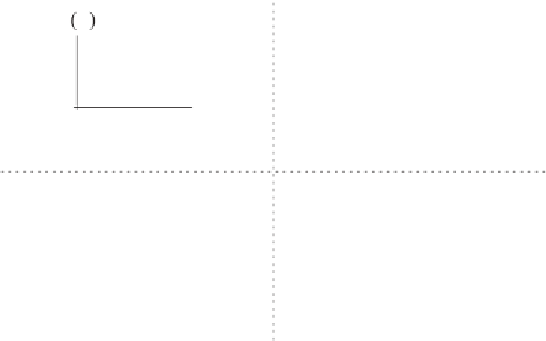Environmental Engineering Reference
In-Depth Information
k
1
p
φ
p
φ
φ
φ
1
p
φ
p
φ
φ
φ
k
2
1
Figure 3.1. Possible shapes of the steady-state pdf as functions of the switching rates
k
1
and
k
2
, with
f
1
(
φ
)
=
1
−
φ
and
f
2
(
φ
)
=−
φ
.
when
k
1
0). We now
have the elements to describe the possible shapes of the pdf as a function of the
parameters
k
1
and
k
2
(see Fig.
3.1
). The modes and the vertical asymptotes of the pdf
are the preferential states of the system. To assess the emergence of noise-induced
transitions we need to compare these preferential states with the deterministic stable
states. When
k
1
<
1(
k
2
<
1) the pdf has a vertical asymptote at
φ
=
1(
φ
=
<
>
>
<
1, noise is unable to create new
states, in that the preferential state of the stochastic system coincides with the stable
state of the underlying deterministic dynamics. In this case noise creates only disorder
in the form of random fluctuations about the stable deterministic state. Conversely,
when both the switching rates
k
1
and
k
2
are greater than one, a new noise-induced state
appears at
1and
k
2
1or
k
1
1and
k
2
φ
m
, i.e., a noise-induced transition emerges when the switching rates
k
1
and
k
2
exceed the threshold
k
1
=
1, although
the noise does not create any new state, it allows for the coexistence of the two steady
states of the underlying deterministic dynamics. Thus noise induces a bistable (i.e.,
bimodal) behavior that is not observed in the deterministic counterpart of the process,
in which only one steady state can exist for a given set of parameters.
It should be noted that in this example the noise is additive in that
g
(
k
2
=
1. Finally, when
k
1
<
1and
k
2
<
φ
)
=
[
f
1
(
φ
)
−
2
−
1
), which is a constant value. Noise-induced transi-
tions emerge even with this simple form of dichotomous noise. These transitions are
then due to the autocorrelation of the dichotomous noise. In fact, if we choose a sym-
metric additive noise, only the correlation term in Eq. (
3.3
) may cause the emergence
of new modes with respect to the deterministic case.
f
2
(
φ
)]
/
(
2
−
1
)
=
1
/
(













Search WWH ::

Custom Search